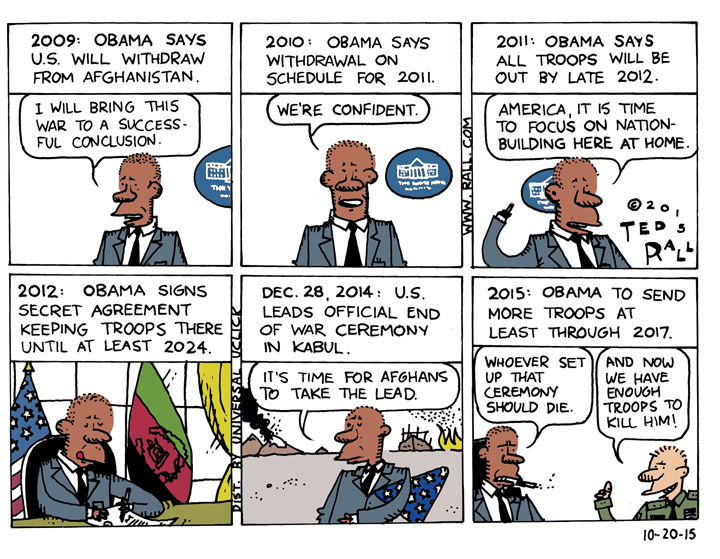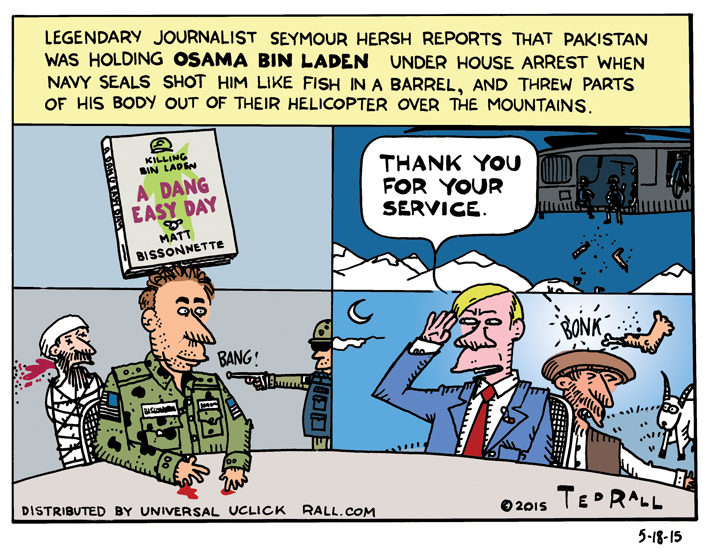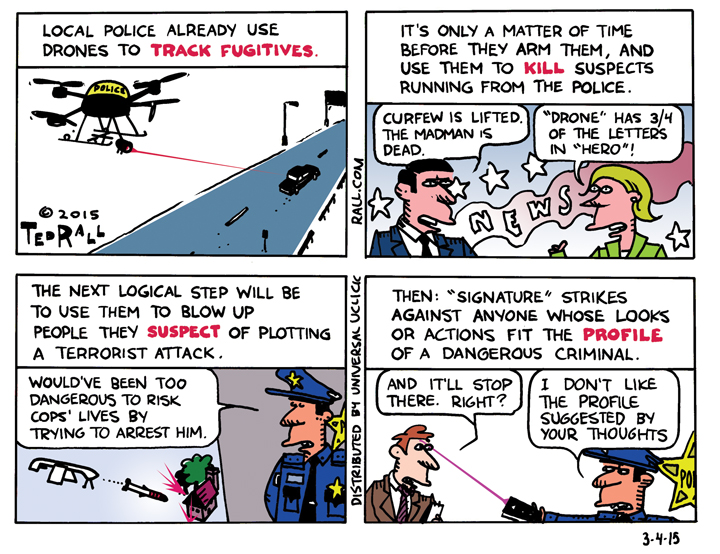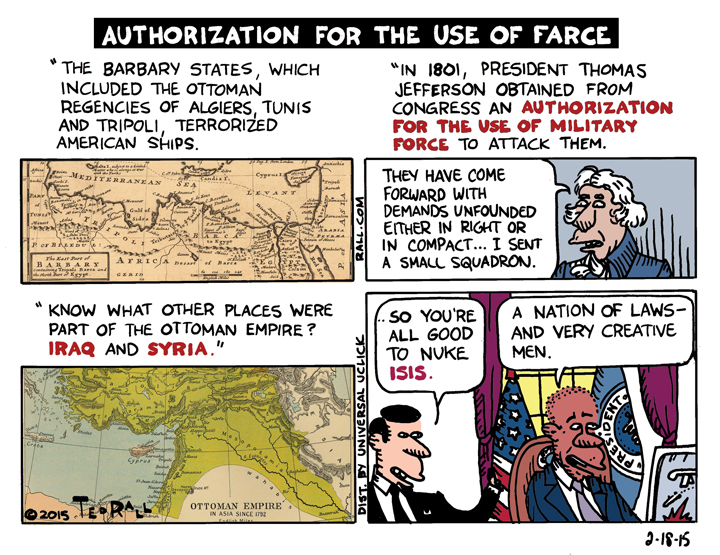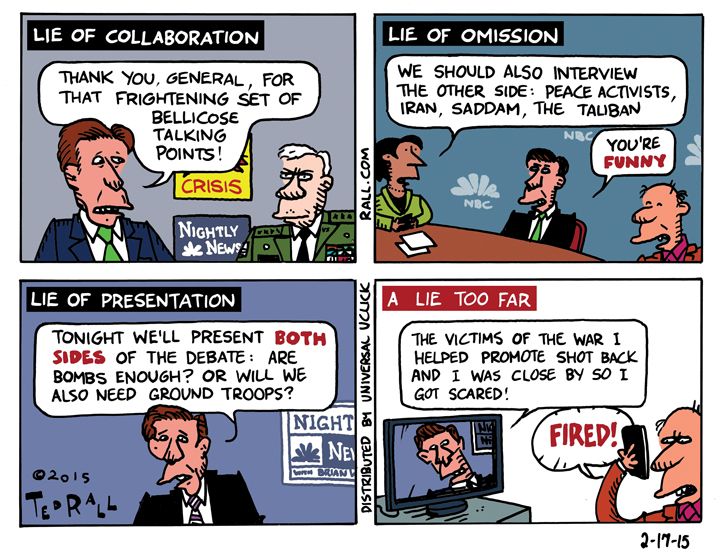Why is it so hard for Obama to deliver on his repeated promises to leave Afghanistan? Because the situation keeps getting worse. Which is exactly why we already should have left.
Trainer Troops in Iraq? Doomed to Failure
Originally published by ANewDomain.net:
President Obama is deploying 450 troops, trainers of Iraqi soldiers, back to Iraq. To fight ISIS this time. The media says this sort of half-measure, neither big enough to make a difference but not nothing, either, reflects the wisdom of compromise. Because “both sides” will criticize.
Both sides are right. It’s a stupid move doomed to failure.

SYNDICATED COLUMN: Military Service is for Suckers

Monday was Memorial Day, when Americans are supposed to remember military veterans, particularly those who made sacrifices — lives, limbs, sanity — fighting our wars.
As usual, rhetoric was abundant. People hung flags. Some placed flowers on military graves. There were parades, including one in which a reporter got hit by a drone. President Obama added an oddly pacifist twist to his annual speech, noting that it was “the first Memorial Day in 14 years that the United States is not engaged in a major ground war.”
Excuse me while I puke.
Talk is nice, but veterans need action. Disgusting but true: when it comes to actual help —spending enough money to make sure they can live with dignity — talk is all the U.S. has to offer.
It isn’t just last year’s scandal at the Veterans Administration, which made vets wait for ages to see a doctor, then faked the books to make itself look responsive — and where a whopping three employees lost their jobs as a result. The Department of Housing and Urban Development estimates that more than 57,000 homeless veterans, some just poor, others suffering from mental illness, sleep on the street on any given night.
The Pentagon can easily afford to solve these problems. But vets aren’t a spending priority. New wars are. For example, we’re fighting a $40 billion-a-year air campaign against ISIS, although the Islamic State can’t attack the U.S. $40 billion is enough to buy every homeless veteran a $700,000 house.
What you might not know is that this isn’t new.
The U.S. has consistently and ruthlessly screwed vets since the beginning. At this point, army recruiters should thank the heavens that American schools don’t teach history; if they did, no one would enlist.
During the Revolutionary War, officers had been promised a pension and half pay for life. After the British were defeated in 1783, however, Congress reneged on its pledge and issued checks for five years pay, period. “If officers felt cheated, enlisted men felt absolutely betrayed…the common soldier got a pat on the back and a shove out the door,” wrote the historian Andrew C. Lannen. “Some soldiers were given land warrants, but it took many years before they became redeemable. “Impoverished veterans in dire need of cash sold them for pennies on the dollar to investors who could afford to wait several years to collect at full value.”
For more than half a century after beating the British, veterans of the War of 1812 got nothing. Finally, as part of a payout to vets of the Mexican War of 1846-1848 — who themselves were made to wait 23 years — the 1812 vets received service pensions in 1871. By then, many had died of their injuries or old age.
Union troops won the Civil War, but that didn’t stop the government from cheating them out of their benefits too. By the end of 1862, the military was only making good on 7% of claims filed by widows and orphans of the fallen. At least 360,000 Union soldiers were killed, leaving close to a million survivors. But 20 years after the war, the pension office only acknowledged receiving 46,000 applications — less than 5% of those eligible.
Though fading from historical memory, the “Bonus Army” was perhaps the most famous example of the American government’s poor treatment of its war heroes.
Repeating the Revolutionary War policy of “I will gladly pay you a thousand Tuesdays from now for your cannon-fodder corpse today,” Congress awarded veterans of World War I service certificates redeemable for pay plus interest — in 1945, more than two decades later. The Great Depression prompted impoverished vets to form a proto-Occupy movement, the Bonus Expeditionary Force.
In 1932, 43,000 Bonus Army members, their families and supporters camped out in Washington to demand that Congress issue immediate payment in cash. Two generals who’d later become notorious hardasses during World War II, Douglas MacArthur and George Patton, led troops to clear out the camps, shooting, burning and injuring hundreds of vets, whom MacArthur smeared as “communists.” Eighteen years after the end of World War I, in 1936, Congress overrode FDR’s veto and paid out the Bonus.
Even those who served in the so-called “good war” got cheated. “According to a VA estimate, only one in seven of the survivors of the nation’s deceased soldiers, sailors, airmen and marines who likely could qualify for the pension actually get the monthly checks,” reported The Charlotte Observer in 2005. These nearly two million survivors include those whose spouses and parents served in World War II, as well as Korea and Vietnam.
Remember this the next time you hear some politician or their media allies claim to “support our troops.”
Support? They don’t even pay them enough to let them sleep inside.
(Ted Rall, syndicated writer and the cartoonist for The Los Angeles Times, is the author of the new critically-acclaimed book “After We Kill You, We Will Welcome You Back As Honored Guests: Unembedded in Afghanistan.” Subscribe to Ted Rall at Beacon.)
COPYRIGHT 2015 TED RALL, DISTRIBUTED BY CREATORS.COM
Bill O’Reilly and VA Head Macdonald: Poor Victims of Brian Williams Disease
Originally Published by ANewDomain:
A couple of weeks ago, I wrote an essay for BreakingModern about the Brian Williams scandal, and how it reflects the sick cult of militarism that has ruled America and its media since 9/11. “You can tell a lot about a society’s values from its lies,” I said.
Williams’ attempt to portray himself as some kind of bad-ass journo-soldier was preceded by Hillary Clinton’s false claim of dodging enemy fire in Bosnia and Connecticut Senator Richard Blumenthal’s lie that he had served in Vietnam.
Now two more public figures are being accused of ginning up accounts of courage in war zones.
FOXNews host Bill O’Reilly is fending off charges that he repeatedly bragged about dodging bullets during the Falklands war though he never came close to the war zone, having been confined by Argentine authorities to the capital of Buenos Aires. He is attempting to defend himself by saying he was caught in a riot there, where he was shot at by police or soldiers, but most of his fellow CBS veterans remember it differently.
O’Reilly, characteristically aggressive, threatened a reporter for the New York Times that he would retaliate if they weren’t fair to him: “I am coming after you with everything I have,” he said. “You can take it as a threat.”
Disclosure: I have appeared several times on “The O’Reilly Factor.” A statement by one of O’Reilly’s accusers sums up my experience: “Nobody gets a fair shake. just wants to beat them up, call them names.” I didn’t care about that, but I’m still annoyed about the fact that, when I went on his show at the beginning of the occupation of Afghanistan to predict that the war would go badly for the United States, he promised on the air — after mocking me and questioning my patriotism — to have me back later to see who was right.
I sure would have liked to have performed my little victory dance.
And now there is another apparent case of an armchair warrior pretending to have served in the military: US Department of Veteran Affairs Secretary Robert MacDonald. He apologized yesterday for saying that he had served in the Army’s elite Special Forces.
In fact, MacDonald graduated from West Point in 1975 and served in the 82nd Airborne Division – hardly the resume of a wimpy pacifist unqualified to attempt to unravel the hot mess that his department has become.
As I wrote about Brian Williams, the O’Reilly and MacDonald cases tell us a lot more about contemporary American culture and the cult of militarism than they do about these two guys.
If it matters, Williams has been in harm’s way in war zones. O’Reilly has an enviable career as a successful TV and radio host, best-selling author and yes, a prehistory as a real journalist.
MacDonald really was a soldier, if not the exact kind of bad-ass super trooper he was compelled to present himself as.
The point is, why do these people, who are incredibly accomplished professionally and in some cases have demonstrated real courage under fire, feel tempted to puff themselves up in this particular way?
We have developed a martial culture to the exclusion of all else. You don’t see teachers thanked for their service on television – hell, you don’t really see teachers on television much at all. Nor nurses. Nor musicians. Nor playwrights. Nor artists. In the United States in 2015, the way that you get people to show you deference is to claim to have fought in one of America’s many optional wars of aggression or, failing that, to have gotten caught in the line of fire as a journalist, or perhaps a former hostage.
If you don’t see that there is something terribly wrong with that, odds are you are either part of the problem or one of its victims.
Authorization for the Use of Farce
A declining American military empire relies on increasingly flimsy legal justifications to attack foreign countries without provocation. Last year, Obama asserted that the 2001 Congressional Authorization for the Use of Military Force authorized him to launch airstrikes against ISIS in Iraq and Syria, even though the AUMF related to Al Qaeda, an enemy of ISIS. Now Obama wants Congress to give him retroactive authorization, even while claiming he was right last year. Why not go even further to stretch logic?
A Lie Too Far
NBC News anchorman Brian Williams got in trouble for fibbing about a supposed close call while embedded with US soldiers occupying Iraq in 2003. Why didn’t he get in trouble for being embedded in the first place? Or for the bigger lies inherent in the way he and other news networks package US government and military propaganda?

